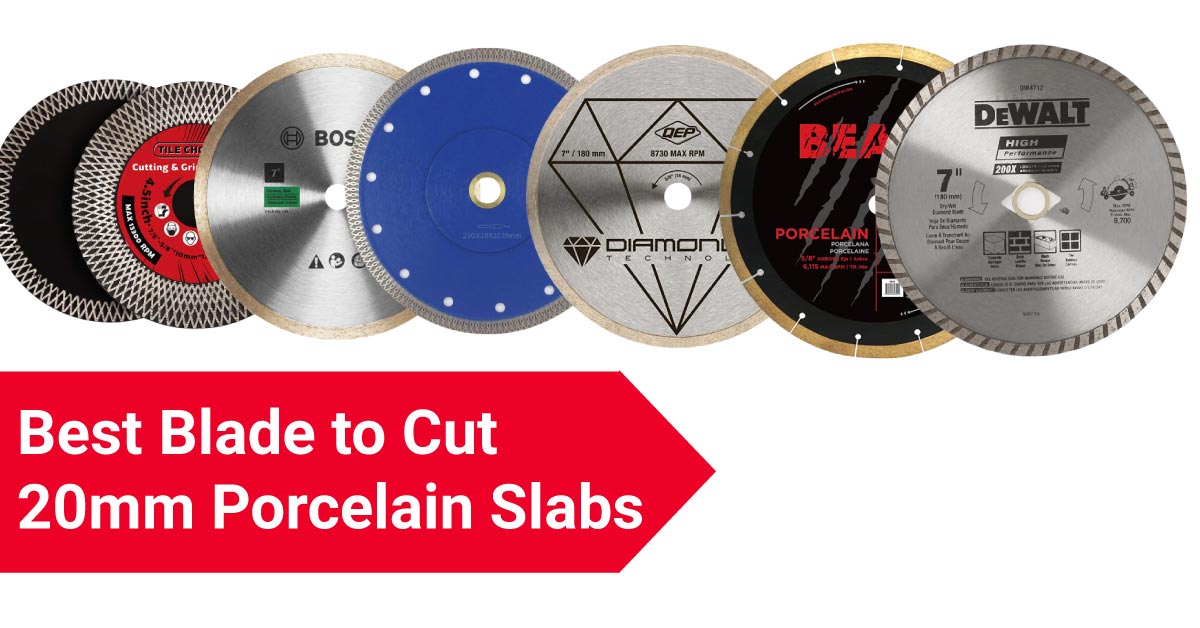Porcelain slabs have become increasingly popular due to their durability, resistance to staining and scratches, and sleek modern appearance. However, cutting porcelain slabs can be challenging and requires the right tools and techniques. Choosing the best blade to cut 20mm porcelain slabs is only one part of the process. There are additional considerations to keep in mind to ensure safe, efficient, and accurate cutting.
This article will cover some additional factors to consider when cutting porcelain slabs. We will discuss the importance of wet cutting, proper blade alignment, cutting speed, blade maintenance, operator safety, and expertise and training. Understanding these additional considerations can help you achieve clean and precise cuts without damaging the material or compromising the operator’s safety.
Properly cutting porcelain slabs requires precision, expertise, and the right tools and techniques. By taking the time to consider these additional factors, you can ensure that your cutting project goes smoothly and produces high-quality results. Whether you’re a professional contractor or a DIY enthusiast, a solid understanding of these factors can help you achieve your cutting goals while minimizing the risk of accidents or damage to the material.
Best blade to cut 20mm porcelain slabs
1. BOSCH DB743S 7-Inch

The BOSCH DB743S is a 7-inch continuous rim diamond blade designed for wet cutting of hard materials such as porcelain, granite, and marble. The blade features high-quality diamonds for long-lasting performance and a continuous rim design for smooth cuts with minimal chipping. Users appreciate the blade’s durability and ability to make precise cuts, even on tough materials.
Pros
- Continuous rim design for smooth, chip-free cutting
- Long lifespan due to high-quality diamond grit
- Suitable for cutting a variety of materials, including tile, stone, and masonry
Cons
- Some users have reported blade warping after extended use
2. DEWALT Diamond Blade 7/8-Inch Arbor, 4-1/2-Inch (DW4725)

The DEWALT Diamond Blade is a 4.5-inch continuous rim blade designed to dry-cut masonry materials such as concrete, brick, and tile. The blade features high-grade diamonds for long-lasting performance and a continuous rim design for smooth cuts with minimal chipping. Users appreciate the blade’s durability and ability to easily cut through tough materials.
Pros
- Continuous rim design for smooth, chip-free cutting
- Suitable for dry cutting of masonry and other tough materials
- Long lifespan due to high-quality diamond grit
Cons
- Can produce a lot of dust during use
- Some users have reported the blade losing teeth after extended use
3. QEP 6-7001Q 7″

The QEP 6-7001Q is a 7-inch continuous-rim diamond blade designed to cut ceramic tiles with wet tile saws. The blade features a high-quality diamond coating for smooth cuts, minimal chipping, and a continuous rim design for precision cutting. Users appreciate the blade’s versatility and ability to cut through ceramic tiles quickly and easily.
Pros
- Continuous rim design for smooth, chip-free cutting
- Suitable for use with wet tile saws
- Affordable price
Cons
- Some users have reported the blade wearing out quickly
- Only suitable for cutting ceramic tile, not other materials
4. EZARC 4-1/2 inch Diamond Blade

The EZARC 4.5-inch diamond blade is a super-thin blade designed for use with angle grinders to cut porcelain, ceramic, granite, and marble tiles. The blade features high-quality diamonds for long-lasting performance and a thin design for fast, precise cuts with minimal chipping. Users appreciate the blade’s ability to cut through tough materials quickly and easily.
Pros
- Super thin design for precise cuts and minimal chipping
- Suitable for cutting a variety of materials, including porcelain, ceramic, granite, and marble
- Affordable price
Cons
- Some users have reported the blade wearing out quickly
- May produce more dust than thicker blades
5. QEP 6-7003Q 7 Inch

The QEP 6-7003Q is a 7-inch continuous rim diamond blade designed for wet cutting of porcelain and ceramic tiles. The blade features a high-quality diamond coating for smooth cuts with minimal chipping and a continuous rim design for precision cutting. Users appreciate the blade’s durability and ability to make precise cuts on hard materials.
Pros
- Continuous rim design for smooth, chip-free cutting
- Suitable for wet cutting of porcelain and ceramic tile
- Extended lifespan due to high-quality diamond grit
Cons
- Some users have reported the blade wearing out quickly
- May not be suitable for cutting other materials
6. Lackmond Beast Pro Porcelain Saw Blade

The 10-inch diameter diamond saw blade with a 5/8-inch arbor size is highly durable and suitable for cutting hard tile, including porcelain. Customers rave about the precision and durability of the blade, which allows for precise cuts and can cut through hard tile with ease. It is a worthwhile investment for frequent users.
Pros
- Explicitly designed for cutting hard tile, including porcelain
- Features a thin kerf cutting edge for precise and fast cuts
- Can be used on both wet and dry tile saws
- Comes with a 5/8 inch arbor
Cons
- May not be suitable for cutting other materials like granite or marble
- Only comes in one size (10 inches)
- Higher price point compared to other brands
7. DEWALT Diamond Blade for Tile (DW4764)

This 10-inch diameter diamond saw blade with a 5/8-inch arbor size is suitable for cutting ceramic and porcelain tiles. It has a wet cutting design for reduced dust and increased precision, as well as highly durable blade construction. It is a bit more expensive than alternatives, but customers feel it is worth the investment.
Pros
- Designed specifically for wet cutting on tile saws
- Features a continuous rim design for smooth, chip-free cuts
- Can be used on porcelain and ceramic tiles
- Comes with a 5/8 inch arbor
Cons
- May not be suitable for use on harder materials like granite or marble
- Higher price point compared to other brands
- Some users have reported that the blade
8. Delta Diamond Piranha Premium 7 Inch

This diamond saw blade is a 7 inch diameter diamond saw blade with a 5/8 inch arbor size. It is suitable for dry or wet cutting of porcelain and ceramic tiles, and is ideal for use with tile saws. Customers appreciate its smooth cuts, versatility, and affordability. It is expensive, but offers good value for the price.
Pros
- Can be used for both dry and wet cutting of porcelain and ceramic tiles.
- Continuous rim design ensures precise and smooth cuts.
- Suitable for high-speed cutting machines.
- 7/8″-5/8″ arbor size fits most saws
Cons
- Some users reported blade wear and tear after heavy use
- May produce more dust than other blades during dry cutting.
9. Diapro 2 Pack-4.5″ Tile Blade

The 4.5-inch diameter diamond saw blade with a 7/8-inch arbor size is suitable for cutting and grinding porcelain tiles, granite, and marble. It comes in a pack of two blades, making it a good value for frequent users.
Pros
- 2-pack provides good value for money.
- Suitable for cutting and grinding porcelain, granite, and marble tiles.
- Can be used with angle grinders and tile saws.
- Fast cutting speed and long lifespan.
Cons
- Some users reported blade warping during heavy use.
- May produce more noise than other blades.
10. Makita 2 Pack – 4” Continuous Diamond Blades

This pack of two 4″ continuous diamond blades is designed for use with 4″+ grinders and circular saws. It can be used for precise cutting of tile, porcelain, and stone, and is available in 5/8″, 20mm, and 7/8″ arbor sizes. Users are generally happy with the blades’ durability and precision, producing clean cuts with minimal chipping. However, they can be noisy when in use, so ear protection is recommended. Overall, these are a solid choice for those in need of a reliable and versatile diamond blade.
Pros
- 2-pack provides good value for money.
- Suitable for precise cutting of tile, porcelain, and stone.
- Can be used with grinders and circular saws.
- 5/8″, 20mm & 7/8″ arbors fit most saws.
Cons
- May produce more noise than other blades.
- Some users reported blade wear and tear after heavy use.
Our Recommendations for the Best Blade to Cut 20mm Porcelain Slabs
We consulted with several experts in the field to help you choose the best blade for cutting 20mm porcelain slabs. Here are their top recommendations:
“The DEWALT DW4764 10-Inch Premium Porcelain Tile Blade is a continuous rim blade with a 10-inch diameter and high-quality diamond for fast, smooth cuts. It’s designed for use with wet-cutting saws and is ideal for cutting porcelain slabs up to 20mm thick.”
“The QEP 6-7006GLQ 7-Inch Continuous Rim Glass Tile Diamond Blade is a versatile blade that can also be used to cut up to 20mm thick porcelain slabs. It features a 7-inch diameter and a continuous rim design for clean, precise cuts.”
“The Lackmond Beast Porcelain Diamond Blade is a premium blade designed specifically for porcelain slabs. It features a segmented rim design for fast, efficient cutting and is available in several sizes to fit different saws and cutting needs.”
Factors to Consider When Choosing a Blade
When cutting 20mm porcelain slabs, choosing the right blade is critical for achieving clean and precise cuts without chipping or cracking the material. There are several factors to consider when selecting a blade, including the blade diameter, type, and diamond quality.
Blade Diameter
The diameter of the blade determines the depth of the cut and the size of the blade’s contact area with the material. For cutting 20mm porcelain slabs, a blade with a diameter of at least 7 inches is recommended. A larger diameter blade will allow you to cut deeper and make fewer passes, reducing the risk of chipping or cracking the material.
Blade Type
Several types of blades are available for cutting porcelain slabs, including continuous rim, segmented, and turbo blades.
Continuous rim blades have a smooth, continuous edge and are ideal for making precise cuts without chipping the material. They are also suitable for cutting thin or fragile materials like porcelain slabs.
Segmented blades have teeth separated by gaps or slots, allowing for faster cutting and improved debris removal. They are recommended for cutting thicker or more challenging materials, such as granite or concrete.
Turbo blades combine continuous and segmented edges, providing a balance between speed and precision. They are suitable for cutting a variety of materials, including porcelain slabs.
Diamond Quality
Diamonds are the cutting material on a blade and come in different qualities, ranging from economy to premium. The quality of the diamond determines the blade’s cutting speed, durability, and cost.
Economy diamonds are typically used for general-purpose cutting and are the most affordable option. They may not last as long as higher-quality diamonds and may require more frequent blade replacements.
Standard diamonds are a mid-range option that balances affordability and performance. They are suitable for cutting various materials, including porcelain slabs, and can provide long-lasting performance with proper maintenance.
Premium diamonds are the highest quality option, offering the best performance and longevity. They are recommended for cutting hard or abrasive materials, such as porcelain slabs, and can provide fast, precise cuts with minimal chipping or cracking.
Other Considerations
In addition to the blade diameter, type, and diamond quality, there are other factors to consider when selecting the best blade for cutting 20mm porcelain slabs.
First, consider the material being cut. Porcelain slabs are hard and brittle, so a blade that is designed specifically for cutting this material is necessary.
Second, consider the speed of the cut. A slower cut speed will produce cleaner cuts and reduce the risk of chipping or cracking the material.
Third, consider the water supply. Using a blade with a built-in water supply can help cool the blade and reduce dust, improving cutting performance and prolonging the blade’s life. Finally, consider the blade’s overall quality and manufacturer. A high-quality blade from a reputable manufacturer will not only provide better cutting performance. Still, it may offer additional features such as noise reduction, vibration reduction, or laser-cut segments.
Additional Considerations for Cutting Porcelain Slabs
In addition to using the right blade, there are several other considerations to remember when cutting porcelain slabs. These include:
Safety
Cutting porcelain slabs can be dangerous, so taking proper safety precautions is important. Wear eye and ear protection, gloves, and a dust mask to protect yourself from flying debris and dust.
Technique
Proper technique is essential for achieving clean and precise cuts without chipping or cracking the material. Use slow and steady pressure when cutting, and avoid forcing the blade through the material.
Maintenance
Regular blade maintenance is essential for ensuring its cutting performance and longevity. Clean the blade after each use and sharpen it as needed.
Wet vs Dry Cutting
Porcelain slabs should be cut using a wet-cutting method, which involves water cooling the blade and reducing dust. Dry cutting can cause the blade to overheat and potentially damage the material. Also, dry cutting can create a lot of dust, harming the operator’s health and creating a mess in the work area.
Proper Blade Alignment
Proper blade alignment is crucial for achieving clean and precise cuts. If the blade is not aligned correctly, it can cause chipping, cracking, or even breakage of the porcelain slab. Before cutting, ensure that the blade is correctly aligned with the cut line, and make minor test cuts to ensure the blade is cutting straight.
Cutting Speed
Cutting speed can impact the cut’s quality and the blade’s life. Cutting too fast can cause the blade to overheat while cutting too slow can result in chipping or cracking. Finding the right balance between speed and precision when cutting porcelain slabs is important. Use a steady and consistent cutting speed to achieve the best results.
Blade Maintenance
Proper blade maintenance is essential for prolonging the blade’s life and maintaining cutting performance. After each use, clean the blade with a soft brush and water to remove any debris. Avoid using harsh chemicals or abrasive materials that can damage the blade. Additionally, check the blade regularly for any signs of wear or damage and replace it as needed.
Operator Safety
Cutting porcelain slabs can be dangerous if proper safety measures are not taken. Ensure the operator wears the appropriate personal protective equipment, such as safety goggles, gloves, and a dust mask. Additionally, ensure that the work area is adequately ventilated and that the cutting equipment is appropriately maintained to minimize the risk of accidents.
Expertise and Training
Cutting porcelain slabs requires expertise and training to ensure safe and accurate cutting. It’s essential to have a skilled operator with experience in cutting porcelain slabs. Additionally, provide training for new operators to ensure they understand the proper cutting techniques and safety procedures.
Cutting porcelain slabs requires attention to detail and proper technique to achieve clean and precise cuts without damaging the material. In addition to choosing the right blade, it’s essential to consider factors such as wet vs dry cutting, proper blade alignment, cutting speed, blade maintenance, operator safety, and operator expertise and training.
Final Words
In conclusion, cutting porcelain slabs requires careful consideration of various factors. They ensure that you use the appropriate blade for the thickness of the porcelain and consider additional factors. They can be wet cutting, proper alignment, cutting speed, blade maintenance, operator safety, and expertise and training. You can achieve clean and precise cuts without damaging the material or risking injury to the operator.
As we have discussed, cutting porcelain slabs must be taken seriously. It requires high precision, expertise, and attention to detail. However, with the right tools, techniques, and knowledge, you can achieve professional-grade results that will impress you.




